

GFA-5503
High Current
3-Channel
Power
Amplifier
OWNER'S MANUAL
Congratulations on your decision to purchase the GFA-5503 3-Channel Power Amplifier. The GFA-5503 is designed for use with Home Theater systems, such as Dolby ProLogic®, THX® or Dolby AC-3®. You have made a wise choice that will reward you with exceptionally accurate and musical sound reproduction for years to come. To realize the full potential of your new amplifier, please read these operating and installation instructions thoroughly before attempting to connect it.
ADCOM offers the enclosed valuable Limited Warranty. Please read the details on the Warranty Card carefully to understand the extent of the protection offered by the Warranty, its reasonable limitations, and what you should do in order to obtain its benefits. Be sure to verify that the serial number printed on the rear panel matches the serial number on the outer carton. If any number is altered or missing, you should notify us immediately in order to ensure that you have received a genuine ADCOM product which has not been opened, mishandled, or tampered with in any way. Always retain your original receipt as a proof of purchase.
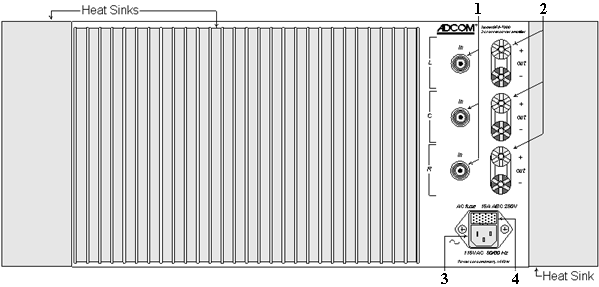
REAR PANEL
L, C, R In (Inputs) (1)
The audio Inputs for the GFA-5503 are through high-quality, gold-plated RCA jacks with Teflon insulators to minimize high-frequency losses, noise, etc. They will accept standard RCA-type plugs, one for each of the three channels: Left, Center, and Right. To insure that the performance designed into the GFA-5503 is preserved, you should use the highest quality audio cables possible. Refer to Inputs section of CONNECTING THE GFA-5503 for proper connections.
The GFA-7000 is "polarity correct". That is it does not invert phase from input to output. Any positive signals at its inputs will appear as a positive signal at its outputs
L, C, R Out (Outputs) (2)
The GFA-5503's connections to the loudspeakers are made through high-grade, 5-way, gold-plated binding post terminals. There are two terminals for each speaker, which are colored RED for the positive (+) output and BLACK for the negative (-) output. To further insure that the performance designed into the GFA-5503 is preserved, you should use the highest quality speaker cables possible. Refer to Outputs section of CONNECTING THE GFA-5503 for proper connections.
AC Power Cord (3)
The AC cord provides power to operate all the GFA-5503's circuits. Its plug can be connected to a standard wall outlet provided the outlet supplies a voltage compatible with the power requirements printed on the rear panel of the GFA-5503. It is possible to disconnect the POWER CORD from the amplifier chassis with a gentle pull on the plug's body. Be sure not to pull on the cord itself. Grasp the body of the plug firmly and carefully ease it out of the socket.
The GFA-5503 is supplied with a three-prong power cord. It has a round connector between the two blade connectors. This plug is designed to be plugged into a "grounded" AC outlet (an outlet that has three holes) only. If you do not have a three-prong outlet, you can purchase a "ground-lifter adapter" from any electronics or hardware store. Be certain to reconnect the ground connector (on the adapter) to the center screw of the outlet cover.
AC Fuse (4)
The AC Fuse protects the electronic circuits of the GFA-5503. This fuse, normally, will blow only if there is an overload within the GFA-5503. It may, however, blow if the amplifier attempts to deliver very high power into very low-impedance loudspeakers. In either case, BE SURE TO REPLACE THE AC FUSE ONLY WITH AN EXACT REPLACEMENT. The proper fuse values are:
| Fuse Rating | BUSS® | Littlefuse® | |
| For 115 volt operation | 15 Amp 250 Volt | ABC-15/250V (3AG) | 314015/250V |
| For 230 volt operation | 8 Amp 250 Volt | AGC-8/250V (3AG) | 312008/250V |
Before attempting to replace a blown fuse, be certain to unplug the AC Power Cord from the AC wall outlet to prevent possible electrical shock.
Replace the AC Fuse only with one identical in type and rating as printed on the rear panel. DO NOT USE ANY SUBSTITUTE FUSES WITH DIFFERENT RATINGS OR VALUES. Failure to observe this precaution may cause serious damage to the amplifier circuits, MAY CREATE A FIRE HAZARD, AND MAY VOID THE WARRANTY.
If the Power LED (6) does not glow, it may be an indication that the AC fuse has blown. If you are not sure, or the amplifier displays other symptoms, please consult the RESOLVING PROBLEMS section on page 12.
To remove the fuse from its holder, first remove the detachable line cord from the line-cord socket. You will need a "flat head" screwdriver with a blade that is approximately ¼" wide to insert under the removable panel of the fuse holder (see diagram). With the screwdriver head in the slot under the fuse holder, gently twist the screwdriver. This will release the removable panel, which then can be easily withdrawn. The fuse is held in place by a plastic clip on the removable panel and can be simply examined, removed and replaced. Remember to replace the fuse only with one of the same type and rating (see above).
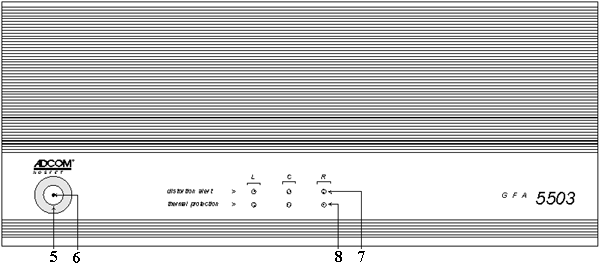
FRONT PANEL
On/Off Switch (5)
The On/Off Switch controls power to the power transformer and circuits of the GFA-5503. Whenever the GFA-5503 is energized the Power LED (6) will glow. To turn on the GFA-5503, press the push-button. It will remain in the "engaged" position while the unit is energized. To turn off the GFA-5503, press the push-button in and release and it will move to the "disengaged" position.
Power LED (6)
This LED will glow whenever the On/Off Switch (5) is turned on and the GFA-5503 is energized. The Power LED indicates that there is AC voltage being fed to the amplifier, but it does not signify that all the amplifier's circuits are in operation. If, for example, the Thermal Protection LED (8) glows, that amplifier channel will not produce sound even though the Power LED may still glow. When the GFA-5503 is turned off, the Power LED will take some time to fade out completely. It may take up to 30 seconds to fully extinguish.
Additionally, the internal power transformer is provided with a thermostat which will interrupt power into the transformer if its temperature exceeds 125·C. This high temperature will seldom, if ever, be encountered unless the amplifier is subjected to abnormal conditions, such as operation into loads of less than 3 ohms at very high listening levels, etc. If the AC Fuse (4) is not blown, the Power LED is out, and the Thermal Protection LED (8) does not glow, this would indicate that the thermostat within the transformer has opened.
Once the temperature within the transformer decreases to a normal level, the thermostat will reset itself automatically and normal operation will resume. If you are to avoid continually tripping the thermostat in the transformer, you must reduce the sound level demands, correct the load impedance of the loudspeakers, or both.
Distortion Alert LEDs (7)
The Distortion Alert circuit is a unique ADCOM distortion detection system which reads all forms of non-linear distortion such as THD, IM, slew-induced, "clipping", etc. The Distortion Alert LEDs will light when distortion reaches 1% regardless of impedance, voltage/current phase angle or the reactance of the loudspeakers which the amplifier is driving. Sometimes, when the amplifier is in use, the LEDs may occasionally flicker during high volume listening, particularly if you are driving low impedances. This flickering is no cause for concern. The LEDs are simply warning you that the amplifier is approaching its maximum power output into the particular loudspeakers you are using. If, however, the Distortion Alert LEDs glow brightly or are illuminated most of the time during playback, you are overdriving the amplifier and should turn down your volume control to reduce the listening level, otherwise it may cause the Thermal Protection LEDs (8) to light or, in extreme cases, damage your loudspeakers.
Thermal Protection LEDs (8)
The GFA-5503 is provided with a thermal protection circuit which will shut down the individual amplifier if any heatsink's temperature reaches 85°C. The Thermal Protection LEDs will light whenever the thermal protection circuit on its respective channel has been triggered and the amplifier is inoperative. The thermal protection circuitry will typically be triggered by very high power demands into impedances much lower than the amplifier is capable of driving at those levels. If any amplifier channel's output through the loudspeaker(s) ceases abruptly, and its Thermal Protection LEDs glows, you will know that its heatsink temperature has become unacceptably high and the circuitry is protecting the amplification devices. Please note that the Power LED (6) will remain on and the amplifier will still be energized. Once the temperature of the heatsink(s) drops to a safe operating level, the amplifier will automatically resume operation.
Activation of the Thermal Protection circuitry in the GFA-5503 is an indication that the amplifier has been overdriven or that the load the loudspeakers are presenting to the amplifier is unreasonably low. If you wish to prevent recurrent activation of the thermal protection circuitry, you must reduce the volume-level demands or correct the load-impedance condition which may be causing activation of this circuitry.
INSTALLATION & HOOKUP
Before your new GFA-5503 left our factory, it was carefully inspected for physical imperfections and tested for all electrical parameters as a routine part of ADCOM's systematic quality control. This, along with full operational and mechanical testing, should ensure a product flawless in both appearance and performance. After you have unpacked the GFA-5503, inspect it for physical damage. Save the shipping carton and all packing material as they are intended to reduce the possibility of transportation damage, should the amplifier ever need to be shipped again. In the unlikely event damage has occurred, notify your dealer immediately and request the name of the carrier so a written claim to cover shipping damages can be initiated. THE RIGHT TO A CLAIM AGAINST A PUBLIC CARRIER CAN BE FORFEITED IF THE CARRIER IS NOT NOTIFIED PROMPTLY IN WRITING AND IF THE SHIPPING CARTON AND PACKING MATERIALS ARE NOT AVAILABLE FOR INSPECTION BY THE CARRIER. SAVE ALL PACKING MATERIALS UNTIL THE CLAIM HAS BEEN SETTLED.
During normal home operation the internal heatsinks of the GFA-5503 may become warm. However, there are instances during high-level playback into low impedances when the heatsinks will become much warmer than usual. To ensure the amplifier's long-term, trouble-free operation it is necessary to provide adequate ventilation for the heatsinks. Therefore, the GFA-5503 should be kept away from external sources of heat such as radiators and hot-air ducts. The GFA-5503 should never be placed with other heat-producing components in a cabinet or enclosure lacking free air flow.
We recommend that you do not stack other components on top of the GFA-5503. This is particularly important If your system includes low-impedance loudspeakers which are difficult to drive, or if you will consistently demand high volume levels from the amplifier and speaker system, Not only will heat generated by the amplifier affect the performance of equipment stacked on top of the GFA-5503, but the free flow of air through the ventilating slots in the amplifier may be partially obstructed. Since the GFA-5503 has a heatsink on the rear panel, you should provide adequate space behind the amplifier as well.
If you observe these recommendations, the GFA-5503 will perform reliably in any reasonable environment. You should also pay attention to such normal considerations as protection from excessive dust and moisture. Occasional vacuuming of accumulated dust on the chassis, heatsinks, panels and around the ventilating slots should be all that is required.
The optimal performance of your new GFA-5503 will ultimately depend on the care with which you make the connections between the amplifier, preamplifier, surround-sound decoder and the loudspeakers. All input and output signal connections should be made only with high quality, low-loss, low capacitance cables following the recommendations in the Inputs and Outputs section of CONNECTING THE GFA-5503.
For those of you who are in a hurry to hook up your amplifier into your system, we have included this quick-connection section. The wiring is straight forward and expeditious, if you use the proper cables and follow this diagram exactly. If you have any difficulties or questions, please refer to the appropriate section of this manual for complete descriptions and instructions.
There are three basic GFA-5503 amplifier configurations. The GFA-5503 can be combined with almost any other amplifier to complete a Home Theater system, but these diagrams represent the most common systems. These configurations are:
Diagram 1.) GFA-5503 with a GFA-5800 (higher-power amplifier)
Diagram 2.) GFA-5503 with a GFA-5500, 5400, 5300 (same or lower-power amplifier)
Diagram 3.) Two GFA-5503s (200 watts X 6 channels)
Diagram 1: GFA-5503 with a GFA-5800
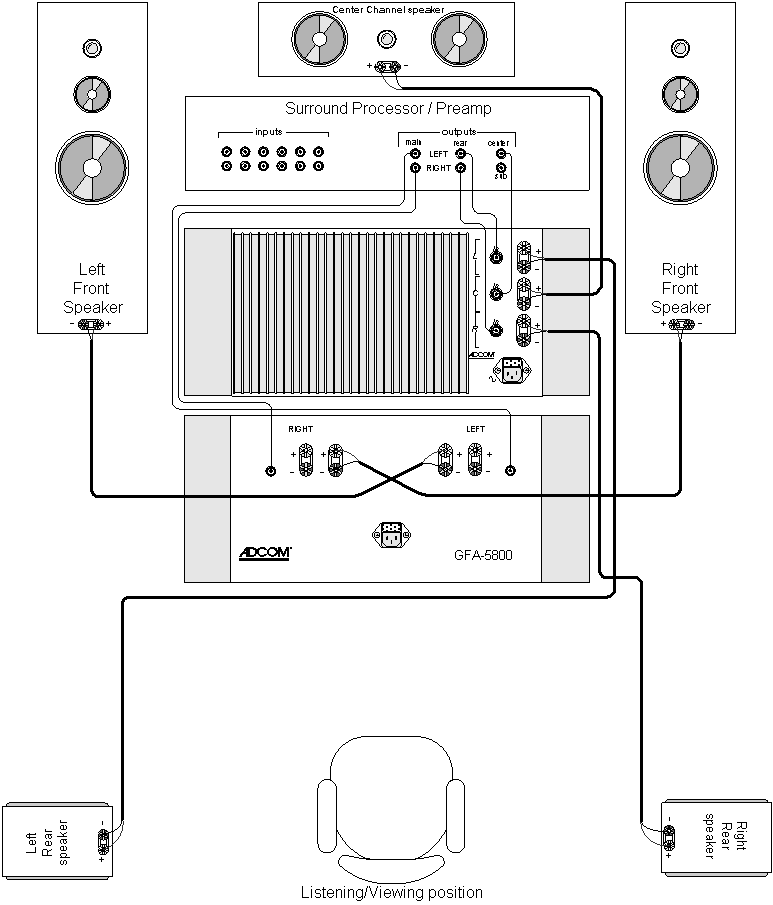
Diagram 2: GFA-5503 with a GFA-5500, 5400, or 5300
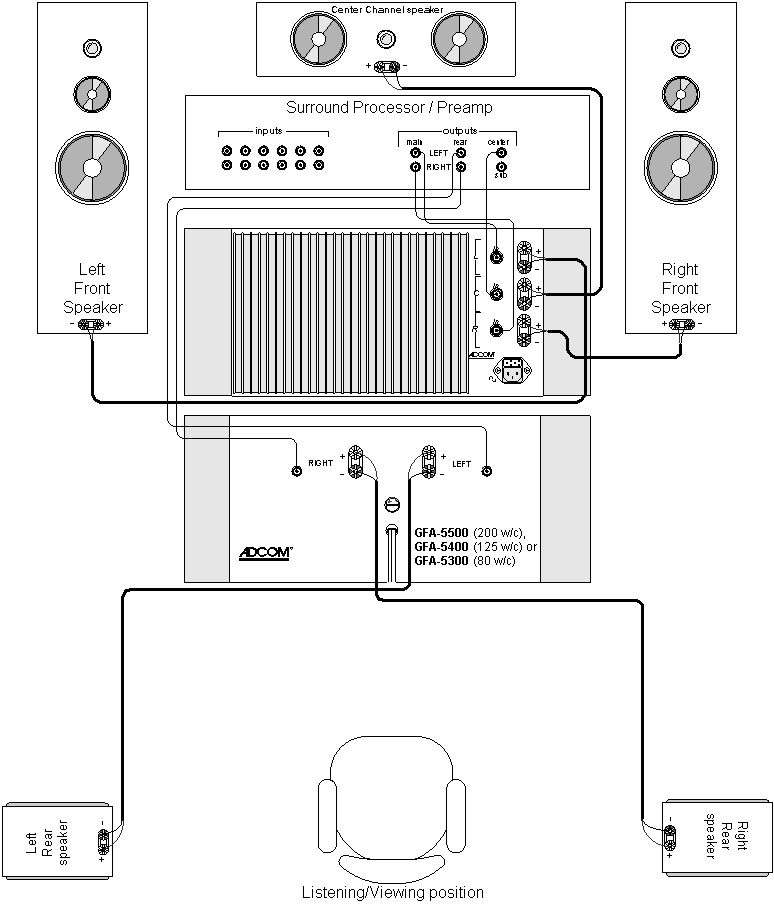
Any time your 2-channel amplifier delivers 200 watts per channel or less, it is advisable to connect it to your rear speakers so that the 3 front speakers receive equal amounts of power (from the GFA-5503). It is recommended that, with 200 watts directed to the 3 front speakers, no less than 50 watts per channel and no more than 200 watts per channel be delivered to the rear speakers.
Diagram 3: Two GFA-5503s (6 channels)
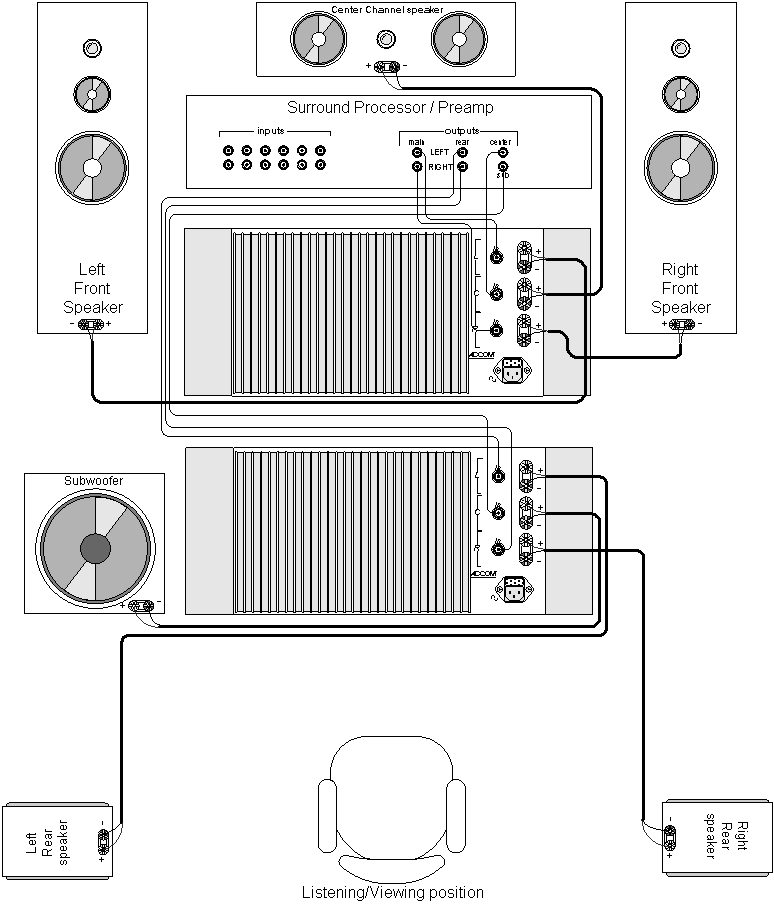
When using a subwoofer that does not have an integral power amplifier (powered subwoofer), there will be a need for 6 independent power amplifiers. This can be met by using two GFA-5503s in almost any channel configuration, but it is recommended that you follow the connecting format diagrammed above.
Remember, that the Left and Right designations are as you are sitting down in your listening/viewing area. The Inputs(1) and Outputs(2) are grouped in three (3) sections on the rear panel and are labeled L (left), C (center) and R (rear).
WARNING
Whenever connections to or from the GFA-5503 are being made, be certain that the AC On/Off Switch (6)of the amplifier is in the OFF position, the AC Power Cord (3) of the amplifier is disconnected from the AC wall outlet and that all associated components are turned off.
Inputs (1):
To preserve the correct surround effects, be certain to connect the RCA cables to the proper RCA Input(1) connector. As a rule of thumb, red is always Right, and either black or white is Left. If you have a three-connector RCA cable, there may be a yellow connector as well. This should be used for the Center channel.
It is recommended that high quality RCA cables be used to connect the GFA-5503 to your preamplifier or processor. The cable should have low capacitance, preferably not more than 100pF for each segment of the cable. Your Adcom Dealer can help you choose a set of cables that will work best for you.
Outputs: (2)
In connecting the amplifier to the loudspeaker, it is vital to maintain proper polarity (positive to positive, negative to negative). On the GFA-5503, the positive Output(2) terminal is color coded RED and labeled "+", and the negative is color coded BLACK and labeled "-". The positive terminal on the speaker will be color coded RED, or will be labeled "+", "pos", "positive", "8 ohms", or "4 ohms". The negative terminal on the speaker will be color coded BLACK, or will be labeled "-", "neg", negative", "C", "Common", "G", or "ground".
 There are various
ways to connect the speaker wire to the Output(2) terminals. The first and most
popular is the "banana plug". It has a "springy", large
contact area for stable performance, and is easily inserted and removed. You may
also use the "spade" connector which should have a maximum width of
0.5 inches and an opening width of no less than 0.25" (see diagram on
right). The spade connector has the largest area of contact for a low-resistance
connection and can be made very secure. You may also use bare wires or pin
connectors to connect to the Output(2) terminal by unscrewing the insulated head
of the binding-post terminal and exposing the hole through the gold-plated post.
Bare wire up to AWG10 or pin connectors up to 0.5" in diameter can be
inserted into the hole. Simple hand-tightening of the insulated head will
securely connect the wire to the terminal. Finger pressure is all that is
required. You should not use pliers or other tools which could damage or
over-tighten the binding-post assembly.
There are various
ways to connect the speaker wire to the Output(2) terminals. The first and most
popular is the "banana plug". It has a "springy", large
contact area for stable performance, and is easily inserted and removed. You may
also use the "spade" connector which should have a maximum width of
0.5 inches and an opening width of no less than 0.25" (see diagram on
right). The spade connector has the largest area of contact for a low-resistance
connection and can be made very secure. You may also use bare wires or pin
connectors to connect to the Output(2) terminal by unscrewing the insulated head
of the binding-post terminal and exposing the hole through the gold-plated post.
Bare wire up to AWG10 or pin connectors up to 0.5" in diameter can be
inserted into the hole. Simple hand-tightening of the insulated head will
securely connect the wire to the terminal. Finger pressure is all that is
required. You should not use pliers or other tools which could damage or
over-tighten the binding-post assembly.
It is very important to use the correct size of wire in order to avoid unnecessary loss of amplifier power in the cable, reduction of amplifier damping factor and other undesirable conditions. Specifications require the use of at least AWG16, stranded, copper cable. Recommended capacitance of the speaker wire should be less than or equal to 50pF per foot.
It is suggested that you follow this chart for speaker lengths and gauges:
up to 36 feet.......... AWG16
up to 72 feet......... AWG14
up to 96
feet......... AWG12
If longer runs are needed, it is best to consult with your Adcom Dealer to maximize the performance of your system under your exact listening conditions.
All loudspeakers having a nominal impedance down to 4 ohms can be connect to and driven by the GFA-5503. The amplifier can drive these low-impedance speakers at more than adequate power levels with no difficulty. It should be noted here that many loudspeaker systems which are nominally rated at 4 ohms drop in impedance, in some parts of their frequency range, to as low as 2 ohms (and sometimes less). You will not experience difficulties even with these very low impedance loads unless you demand excessively high volumes levels from your system.
In most applications, you can drive two or more sets of loudspeakers. You should note, however, that when loudspeakers are wired in parallel, the impedance presented to the amplifier is lower than the nominal impedance of each loudspeaker. In other words, if you parallel two sets of 8-ohm loudspeakers, the resultant impedance presented to the amplifier will be 4 ohms. If 8-ohm and 4-ohm loudspeakers are paralleled, the resultant impedance will be approximately 2.6 ohms. In this last situation, depending upon the lowest impedance of the nominally 4-ohm speakers, and if excessive power demands are placed upon the amplifier, you may trigger the Thermal Protection on the amplifier or trigger the internal protection devices. If you believe that this is a possibility, please refer to RESOLVING PROBLEMS on page 12. For convenient switching of multiple sets of speakers with impedance protection for the amplifier, you should consider the use of an ADCOM speaker selector. These are available from your local ADCOM Dealer.
When turning a system of separate components on or off, there is a proper sequence to insure that no transient surges appear at your loudspeakers. If you own a vacuum-tube preamp, then follow the turn-on wait time according to its manufacturer
When turning ON your system, always turn on your SOURCES (CDs, tape decks, DACs, DATs, etc.) first. Then turn on your PREAMPLIFIER, and finally turn on your AMPLIFIER(S).
When turning OFF your system, always turn off your AMPLIFIER(S) first. Wait for 20 to 30 seconds for the amplifier(s) to discharge completely, then turn off your PREAMPLIFIER. After that, you may turn off the rest of the system.
If you wish to automatically sequence the entire turn-on/turn-off procedure by simply pressing one button, ADCOM manufactures the ACE-515. It operates as a sequencer for your system, a surge protector for your system, and a filter for RFI, EMI and noise from the AC power line itself. Ask your ADCOM Dealer for more information.
Great care has been taken by ADCOM to ensure that your amplifier is as flawless in appearance as it is electronically. The front panel is a heavy-gauge, high-grade aluminum extrusion carefully finished and anodized for durability. The chassis, top cover and rear panel are heavy-gauge steel that has been powder coated and baked to ensure a lasting finish. If the front panel, top or sides become dusty or fingerprinted, they can be cleaned with a soft lint-free cloth, slightly dampened with a very mild detergent solution or glass cleaner. DO NOT SPRAY OR POUR LIQUIDS OF ANY KIND ON THE GFA-5503.
TROUBLESHOOTING
Use the chart below to solve common situations that don't require professional attention. If the steps stated in POSSIBLE SOLUTION do not resolve your problem, then please contact your Adcom Dealer or call the Adcom Customer Service Department. Any problems not covered here should be brought to the attention of your Adcom Dealer or Adcom Customer Service Department.
A special note on "hum": When there is a low-volume "hum" audible throughout your speakers, even with the main volume turned all the way down, you have a common phenomenon known as a "ground loop". A ground loop is basically a difference in ground voltages between two or more components which are connected electrically and which creates multiple current paths where there must only be one. This difference in potential creates a 60Hz low-level sound (approximately a low A#), that appears to "hum", hence the name.
It can be caused by adding new components to your system, but that does not imply there is anything electrically wrong with any new component. With the advent of audio/video and home theater systems, the problem has become commonplace. Generally, the cause is the Cable-TV incoming signal line. This new incoming line may add an additional ground at a different potential from the AC line ground of your other equipment.
|
SYMPTOM |
POSSIBLE REASON |
POSSIBLE SOLUTION |
|
Power LED does not glow. No sound. |
AC Power Cord(3) not plugged in. |
Plug in AC Power Cord(3). |
|
AC Fuse(4) blown. |
Replace AC Fuse(4). | |
|
Transformer thermal protection engaged |
Wait until unit cools down. It will reset. | |
|
Power LED glows, but no sound. |
Preamp or source unit is not on. |
Make sure whole system is on. |
|
Connections in rear of amp are loose. |
Verify all connections on rear of amp. | |
|
One channel not producing sound. |
Input(1) or Output(2) connectors disconnected or loose. |
Verify both sets of connections on that channel. |
|
Speaker disconnected. |
Verify connection at speaker. | |
|
Internal protection engaged |
Bring to Dealer or Service Center. | |
|
Hum from all speakers at any volume. |
Ground loop (difference in ground voltages between components). |
If Cable TV is present (see Note 1). |
|
If Cable TV is not present (see Note 2). | ||
|
Hum from all speakers (hum goes up or down with volume). |
Problem with source unit (CD, tape, etc.) or RCA cable connecting that source unit to the preamp. |
Try different source (tuner, tape, etc.) and/or different RCA cable |
|
Hum from the amplifier itself |
Some major appliance, dimmer, halogen or fluorescent light is creating interference. |
Make sure all appliances, dimmers and suspect lights are off. |
Note 1: Cable TV systems can sometimes contribute to ground-loop problems which cause "hum". To determine if your cable system is the contributing factor, disconnect the Cable-TV incoming signal line (round, 75W) at the wall, or the first component to which the cable is connected to (i.e. the cable box, or VCR). If the hum is no longer present, you must insert a "75W Ground Loop Isolator" before reconnecting the line. You should check with your Adcom Dealer to obtain one. If the "75W Ground Loop Isolator" works only partially or not at all, then please read Note 2 to complete the troubleshooting procedure.
Note 2: Make sure that the power amplifier is at least 6" from the Preamp and/or Processor. Usually putting another component between them is sufficient to minimize the hum. If this does not reduce the hum, turn the system off and disconnect all Inputs(1) from the amplifier. If the hum still persists, then your Dealer or Service Center must examine the amplifier. If the hum disappears, try another set of RCA cables. Connect one RCA cable at a time to see if one specific cable or component is responsible. If any or all cables cause the hum to appear, then the preamp or processor should be evaluated for proper operation by your Dealer or Authorized Service Center.
ADCOM has a Technical Service Department to answer questions pertinent to the installation and operation of your unit. In the event of difficulty, please contact us for prompt advice. Please have the following information readily at hand: the unit's model and serial numbers, and dealer from whom it was bought. If your problem cannot be resolved through our combined efforts, we may refer you to an authorized repair agency, or authorize return of the unit to our factory. To aid us in directing you to a convenient service center, it would be helpful if you indicate which major city is accessible to your home.
Please address mail inquiries to:
ADCOM Service Corporation
11 Elkins Road
East
Brunswick, NJ 08816
U.S.A.
Phone or Fax inquiries to:
Voice: 908-390-1130
Fax: 908-390-9152
Monday
through Friday
9:00 AM to 5:00 PM Eastern Time
UNDER NO CIRCUMSTANCES SHOULD YOUR UNIT BE SHIPPED TO OUR FACTORY WITHOUT PRIOR AUTHORIZATION, OR PACKED IN OTHER THAN ITS ORIGINAL CARTON AND FILLERS.
For fax inquires, please include a return fax or voice number for the reply. When calling or writing about your GFA-5503, be sure to note and refer to its serial number as well as the date of purchase and the dealer from whom it was purchased. In the event the unit must be returned to our factory for service, you will be instructed on the proper procedure when you call or write for a Return Authorization. For warranty coverage, a copy of the original proof of purchase is required. If you have no original copy, please contact your dealer to obtain a duplicate copy.
If the original shipping carton and its fillers have been lost, discarded, or damaged, a duplicate carton may be obtained from our Service Department for a nominal charge.
Always ship PREPAID VIA UNITED PARCEL SERVICE (UPS) OR OTHER APPROVED CARRIER. DO NOT SHIP VIA PARCEL POST, since the packing was not designed to withstand rough Parcel Post handling. FREIGHT COLLECT SHIPMENTS CAN NOT BE ACCEPTED UNDER ANY CIRCUMSTANCES.
GFA-5503 SPECIFICATIONS
Power Rating (To FTC Requirements)
200 watts continuous average power into 8 ohms at any frequency: 20Hz to 20kHz with all channels driven at less than 0.18% THD
350 watts continuous average power into 4 ohms at any frequency: 20Hz to 20kHz with all channels driven at less than 0.18% THD
IM Distortion (SMPTE)
1 watt to 200 watts into 8 ohms..... < 0.05%
1 watt to 350 watts into 4 ohms..... < 0.05%
IM Distortion (CCIF, Any Combination from 4kHz to 20kHz)
200 watts into 8 ohms..... < 0.04%
350 watts into 4 ohms..... < 0.04%
THD + Noise at 200 watts into 8 ohms (Typical)
20Hz..... 0.018%
1kHz..... 0.02%
10kHz..... 0.07%
20kHz..... 0.13%
THD + Noise at 350 watts into 4 ohms (Typical)
20Hz..... 0.018%
1kHz..... 0.02%
10kHz..... 0.08%
20kHz..... 0.16%
Frequency Response @ 1 watt into 8 ohms (10Hz to 20kHz)..... +0, -0.25dB
Power Bandwidth (-3dB)..... 3Hz to 130kHz
Dynamic Headroom into 4 ohms..... 1.7dB
Signal to Noise Ratio, "A" Weighted (200 watts into 8 ohms)..... >100dB
Gain...... 29dB
Input Sensitivity
for 1 watt..... 0.1 volts
for 200 watts..... 1.4 volts
Input Impedance..... 49.9kW
Damping Factor (20Hz to 20kHz)..... >700
Rise Time (5kHz, 90V, peak-to-peak square wave, 20% to 80%)..... 1.5mS
Power Consumption (Continuous, Both Channels Driven)
Quiescent..... 199VA
200 watts into 8 ohms..... 855VA
Maximum..... 1440VA
Power (Available in 230VAC on special order)..... 115VAC - 50/60Hz
Chassis Dimensions..... 7" (178mm) x 17" (432mm) x 16" (406mm)
Maximum Dimensions..... 7¼" (184mm) x 17" (432mm) x 16" (406mm)
Weight..... 57 lb. (10.0kg)
Weight, Packed..... 63 lb. (11.3kg)